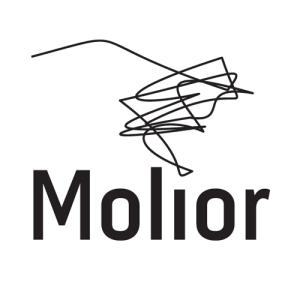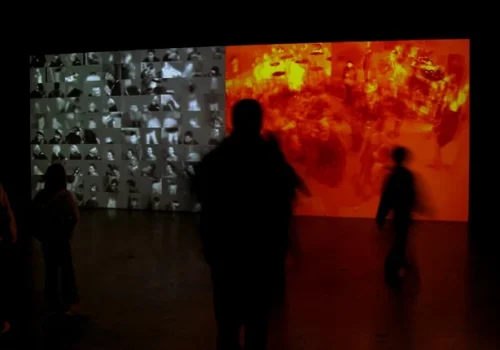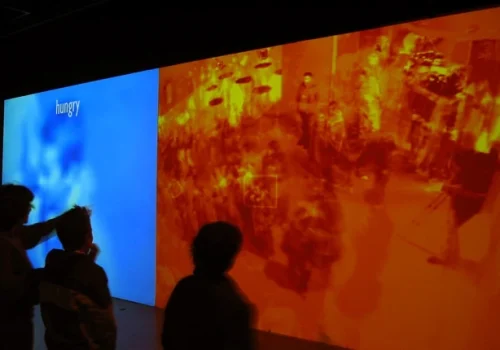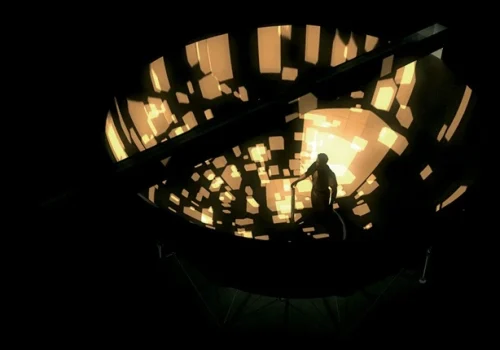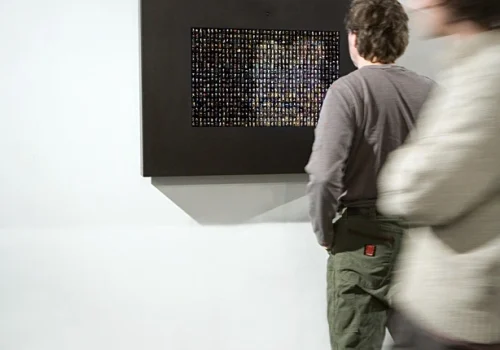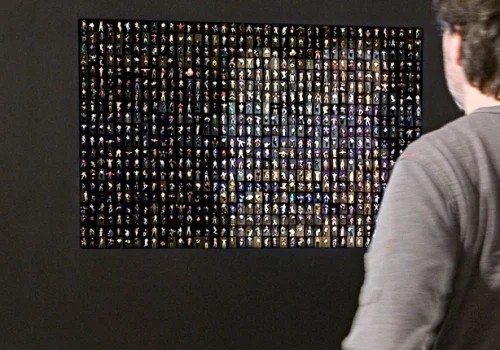SYNTHETIC TIMES - Media Art China 2008
National Art Museum of China (NAMOC), Beijing
From June 10th to July 3rd, 2008
Molior has been invited to participate in SYNTHETIC TIMES – Media Art China 2008, from June 10 to July 3, 2008, one of the major cultural events associated with the Olympic Games in Beijing. Right in the heart of the capital at the National Art Museum of China (NAMOC), the only national art museum dedicated to modern and contemporary arts, the exhibit will showcase forty-four new media works created by artists from approximately thirty different countries.
Molior will be presenting three major works by internationally-renowned Canadian artists: Luc Courchesne, David Rokeby et Rafael Lozano-Hemmer. SYNTHETIC TIMES – Media Art China 2008 is an unprecedented artistic event in the cultural history of contemporary China, spotlighting the most innovative current and landmark works, as selected by Mr. Zhang Ga, artistic director and curator.
Zhang Ga
Zhang Ga is a media art curator, professor of Media Art at Academy of Arts and Design, Tsinghua University (Beijing), and associate professor of Media Design at the School of Art, Media and Technology at Parsons The New School for Design (New York). He also holds appointments as Consulting Curator of Media Art at the National Art Museum of China, Senior Researcher at the Media x Design Lab of EPFL | Swiss Federal Institute of Technology Lausanne and Visiting Scientist at the MIT Media Lab in the U.S. He was Artistic Director / Curator of Synthetic Times: International New Media Art Exhibition, a Beijing Olympics Cultural Project organized by the National Art Museum of China in 2008 (catalogue by the MIT Press), among numerous other curatorial projects. He has been on many jury and consultation committees including the (former) World Trade Center Artist Residency Program, Rockefeller New Media Fellowship National Nomination Committee, Prix Ars Electronica among others. He organized and curated the First, Second and Third Beijing International New Media Art Exhibitions and Symposiums, extending the global new media art discourse into mainland China. He has lectured widely around the world; most recently he was a keynote speaker at Re:Live09, Third International Conference on the Histories of Media Art, Science and Technology. In 2010, he founded China’s first media art lab at Tianghua University.
Andrée Duchaine
Andrée Duchaine has worked in the visual arts area since several years. From 1974 to 1984 she was involved in setting up the video section at Vehicule Art Gallery and organized and curated VIDEO 84, the first international video encounters in Montreal. Mrs Duchaine curated several video art exhibitions in Europe, the United States and Canada. Between 1985 and 1995 she settled in Paris where she founded a short film distribution company. She worked with T.V. channels across the world.
Andrée Duchaine taught at Paris VIII, at the Université du Québec à Montréal and at the Ottawa University. In 2001 she founded a non-profit company Le Groupe Molior producing, curating and disseminating new media works.
Artists & works
David Rokeby
Taken
2002
Interactive installation
Description of the work
Taken is a surveillance installation that provides two readings of the activities in the gallery space. A large gallery space has one wall taken up by two very large projections. On the left hand side, gallery visitors are extracted from the ground of the gallery floors and walls, and then looped back onto themselves at 20 seconds intervals. The result is that every action that has taken place in the gallery since the computer was turned on occurs together on the screen, repeating every 20 seconds. The image stream provides a kind of seething chaos of activity that can be read both as a statistical plot of gallery activities (where do most people stand to regard the piece? Do they move around?) and as a record of each act of each visitor. The image is densely social, deeply layered and chaotic. The right hand side is a cooler catalogue of the gallery visitors. Individual visitors are tracked within the space. Their heads are zoomed in on, and adjectives are attributed to them (i.e. ‘unsuspecting’, ‘complicit’, ‘hungry’). These individual head shots are collected as a set of the last 200 visitors and presented as a matrix of 100 or occasionally all 200 shots, moving in slow motion. This side is analytical and highly ordered and rather threatening.
Biography
Vit et travaille à Toronto
David Rokeby creates interactive installations that react to the presence of the viewer or explore the potential of the database. His works also comprise interfaces that make it possible to capture and transform the movement of individuals into sounds and images.
He regularly exhibits in Canada, the US, Europe and Asia, notably at the Beall Centre For Art + Technology (Irvine, California) in 2015, at Fresnoy studio national des arts contemporains (Tourcoing, France) in 2012, and the Whitney Museum of American Art (New York). He has participated in international events, such as Electrohype 2010 (Ystads, Sweden) and Mois de la photo à Montréal (2009), Transmediale Festival (Berlin, Allemagne) and the São Paulo Biennale in 2007. Molior presented his works in Transitions / Transiciones, at the Centro Cultural de la Pontificia Universidad Católica del Perú (PUCP) in 2007, and again at SYNTHETIC TIMES – Media Art China 2008 at the National Art Museum of China (NAMOC), Beijing.
In 1988, he received the Petro-Canada award for media arts, the Ars Electronica Award of Distinction for Interactive Art (Austria) in 1991, in 1997 (jointly with Paul Garrin), and again in 2002, the same year that he received the Governor General’s Award for Visual and Media Arts.
The Montreal Museum of Fine Arts, the National Gallery of Canada, the Fondation Daniel Langlois and the Agnes Etherington Art Center have acquired his works. David Rokeby has also created several public art works.
Luc Courchesne
Where are You?
Description of the work
An immersive existence simulator and telepresence apparatus.
In Where are you? visitors are invited to fly, as in dreams, through a world of many dimensions, between past and future, light and darkness, the public and private. The immersed visitors use a joystick to move in the X, Y and Z axis of an information/experience space where scale matters.
At scale 0, the world looks like a simple XYZ grid defining the experience of the navigable space. At scale +1, the world turns into an archive of pictures, sounds, texts and objects (the author’s). Zooming out at scale +2, elements of this archive become particles in a “molecular” world of self-organizing clouds of lights reminiscent of late 19th century impressionistic views of the world and of a nascent abstraction. Zooming yet further out at scale +3 reveals a sublime landscape of mountains and valleys in tune with the 18th century idea of the picturesque.
At all these scales, visitors will encounter other inhabitants: live ones through telepresence links (if activated), pre-recorded subjects in video windows and, ultimately, themselves when hidden cameras transmit their own image in this constructed world. In Where are you? the subject (visitor, actor, protagonist) controls his/her position, the path and speed of his/her journey and, more interestingly perhaps, the scale at which he/she is prepared to “exist”.”
Support credits :
General concept, design, scenario, direction, production: Luc Courchesne
Software design, contents modeling and integration: Guillaume Langlois
Music, sound design, 3D audio systems: Luc Martinez
Lens design: D’nardo Colucci, The Elumenati; Simon Thibault, Immervision
Collaboration to screen design and fabrication: Sébastien Bire, Sébastien Dallaire
Created in collaboration with Université de Montréal and the Society for Arts and Technology [SAT]
Biography
Luc Courchesne is a prominent pioneer in the digital arts field. He rapidly adopted computer technologies to create conversational video portraits. He then rendered the landscape in “panascopic” images that allowed for a visual immersion. His recent work consists of experiential devices that combine a virtual space with a horizon of human interactions, interactive immersive installations, and works exploring telepresence.
His work is regularly shown in Canada and abroad and he participated in several major events. In 1997, he was awarded the Grand Prize if the first NTT InterCommunication Center biennial in Tokyo, and in 1999 the Award of distinction in the Interactive art category of the Prix Ars Electronica in Linz, Autria. Molior presented his work at eARTS BEYOND: Shanghai International Gallery Exhibition of Media Art (Shanghai) in 2009 and at SYNTHETIC TIMES – Media Art China 2008, at the National Art Museum of China (NAMOC), Beijing in 2008.
An honorary professor at Université de Montréal, Luc Courchesne is also a founding member of the Society for Arts and Technology, co-director of the SAT | Metalab and a member of the Royal Canadian Academy of Arts. He is represented by Pierre-François Ouellette Art Contemporain.
His works are included in private collections and those of several public institutions, in particular the National Gallery of Canada, which acquired one of his interactive installations.
Rafael Lozano-Hemmer
Eye Contact : Shadowbox 1
Description of the work
Eye Contact is the first piece of the ShadowBox series of interactive displays with a built-in computerized tracking system. This piece shows eight hundred simultaneous videos of people lying down, resting. As soon as a public member is detected, his or her presence triggers the miniature video portraits to wake up: hundreds of people simultaneously turn to look at the visitor directly, creating an uncanny experience that questions who is the observer and who is the observed.
Biography
Rafael Lozano-Hemmer was born in Mexico City in 1967. In 1989 he received a B.Sc. in Physical Chemistry from Concordia University in Montréal, Canada.
Electronic artist, develops large-scale interactive installations in public space, usually deploying new technologies and custom-made physical interfaces. Using robotics, projections, sound, internet and cell-phone links, sensors and other devices, his installations aim to provide “temporary antimonuments for alien agency”. His work has been commissioned for events such as the Millennium Celebrations in Mexico City (1999), the Cultural Capital of Europe in Rotterdam (2001), the United Nations’ World Summit of Cities in Lyon (France, 2003), the opening of the Yamaguchi Centre for Art and Media in Japan (2003) and the Expansion of the European Union in Dublin (2004).
His work in kinetic sculpture, responsive environments, video installation and photography has been shown in two dozen countries, including Venice Biennial (Italy), Art Basel Unlimited (Switzerland), the Sydney Biennial (Australia), the Liverpool Biennial (UK), the Shanghai Biennial (China), the Istanbul Biennial (Turkey), the Havana Biennal (Cuba) and others. His work is in private and public contemporary art collections such as the Museum of Modern Art in New York, the Jumex collection in Mexico, the Daros Foundation in Zürich and the Tate Collection in London.
